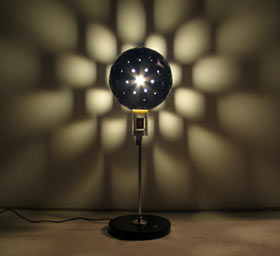« News World
KINETICA 2009, UK'S FIRST KINETIC, ELECTRONIC & NEW MEDIA ART FAIR
Carnivorous lampshades, pole dancing robots, man-animal-machine hybrids, mechanical writing machines, subliminal and sensitive installations, mesmerising light sculptures and cybernetics are just some of the incredible exhibits at Kinetica Art Fair, the UK’s first art fair dedicated to kinetic, robotic, sound, light and time-based art, that took place in London from February 27 to March 2.?
Kinetic art is art that has a life of it’s own. Pioneered by world famous artists including Maholy Nagy, Jean Tinguely, Marcel Duchamp and Alexander Calder during the 1900s, modern contemporary kinetic and electronic artworks utilize and warp technology itself, to explore, nurture and comment on our evolutionary processes and challenge scientific and universal exploration.
Kinetica Art Fair, was developed by Kinetica Museum in partnership with P3 with the support of the Contemporary Art Society. The fair featured well known artists from across the world including Daniel Chadwick, Sam Buxton, Jason Bruges, Martin Richman and Tim Lewis. More than 25 galleries and organizations specializing in kinetic, electronic and new media art participated and over 150 artists exhibited their works. The Fair provided unparalleled opportunities for the public and collectors alike to view and buy work from this thriving international movement, and to participate in talks, workshops and performances.
Kinetica gathered exhibitors from around the world, including: body>data>space, Node London, Laikingland, Shadow Robots, Patrick Heide Gallery, Computer Art Society, Holotronica, Themersons Press, Mute Magazine, Giles Walker, Tim Lewis, Contemporary Art Society, Kinetica Museum, FACT/ Bosch & Simmons, Gallery [DAM] Berlin, Material Beliefs (James Agar/Alex Zivanovic), Jason Bruges Studio, Kinetic Art Organization and Chris O Shea/ Cinimod Studio.
Of note at Kinetica 2009 were the following artists and projects:
Seth Riskin: Seth, a former U.S. national champion gymnast, is an artist and a ‘teacher of light’. He brings his astonishing physical ability to his Light Dance art. In silent, space-defining performances, Riskin’s precise movements articulate light effects that extend from his body. He performed in Kinetica Art Fair’s opening show on February 27.
Tim Lewis creates moving sculptures that blur the boundaries between man and machine. He gives inanimate objects attributes they do not normally possess allowing them to interact with people and the environment around them.
Daniel Chadwick creates mobiles made up of kinetic solar systems which rotate and revolve as they orbit each other. Sometimes using tiny solar-powered motors to propel the kinetic elements, he also employs light and lasers to illuminate the struggle between two and three dimensionality.
Material Beliefs is a collaboration between designers and scientists/engineers and comprises of Aleksandar Zivanovic, James Auger and Jimmy Loizeau. The project explores an alternative approach to bringing robots into the domestic environment, exploring both the aesthetics and functionality that may elicit a symbiotic coexistence with humans in their homes. For Kinetica 2009, Material Beliefs have created a Carnivorous Lampshade Robot inspired by the pitcher plant, a carnivorous plant that attracts and consumes insects to survive. The insects fall into the plant and are unable to escape. In the same way, this spherical lampshade has multiple holes in its surface which are long funnels going deep into the lamp. Insects are attracted to the light shining out of the holes, enter the lamp and are trapped. Eventually they die and fall into the microbial fuel cell underneath. This generates electricity which is stored and used to power a series of low power ultraviolet LEDs. A light sensor detects when the house lights are turned off and switches on the LEDs, attracting insects throughout the night.
Sam Buxton’s work continually blurs the lines between art, science and design. He specialises in developing objects that can communicate the delicate relationship between the human body and its environment.
Martin Richman works with light, colour and space in both the private and public realms to explore our experience of the space that we occupy. He has worked on major public projects and collaborative works with architects and engineers through to discrete sculptures that occupy a variety of spaces from whole rooms to the space between two books.
Giles Walker, is a scrap artist, creating work from readily available rubbish and scrap. For Peepshow, his pole dancing robots are powered by 12V motors found in cars (windscreen wiper motors etc) and then controlled through a PC.?
For further information visit: www.kinetica-museum.org
Filed Under: News World




































